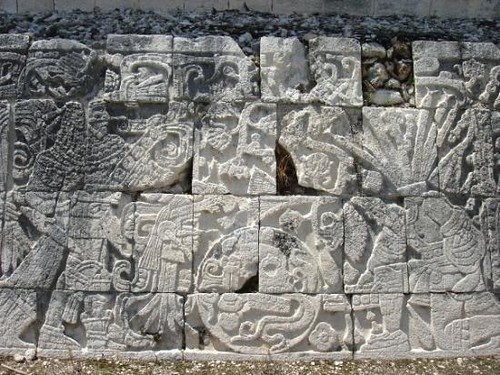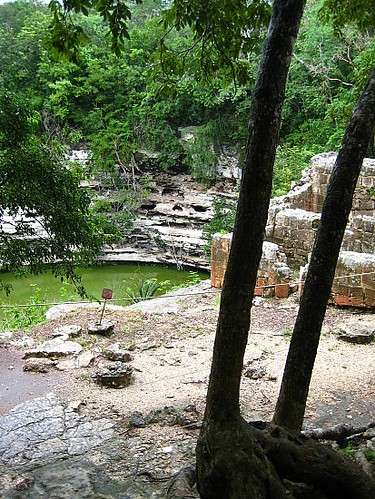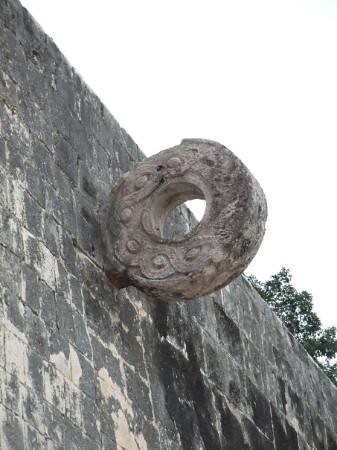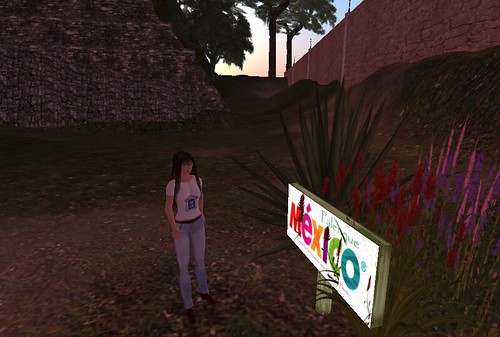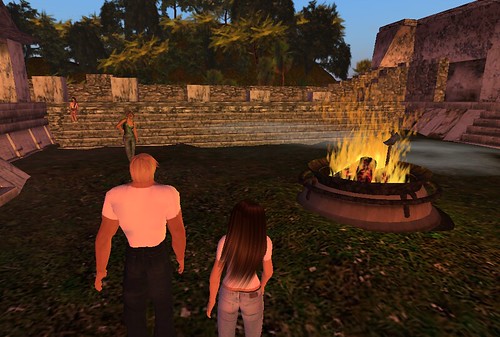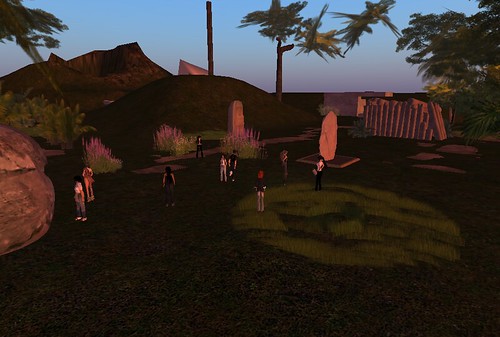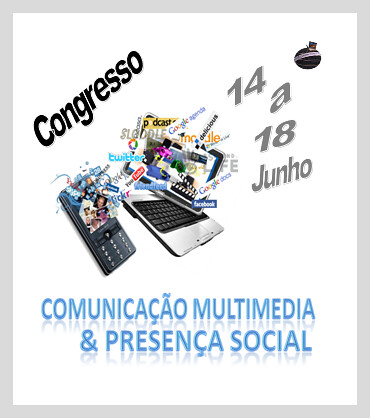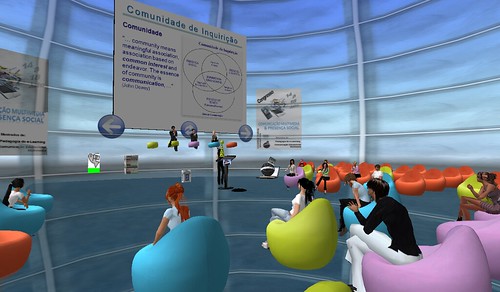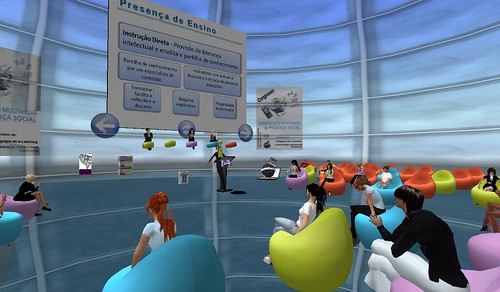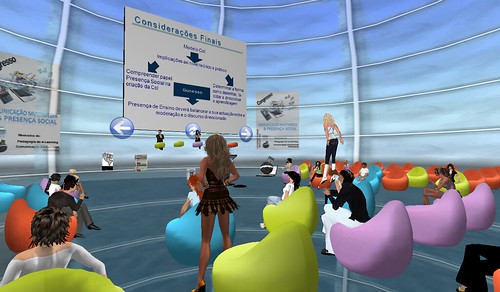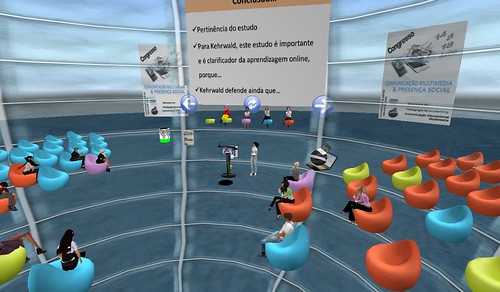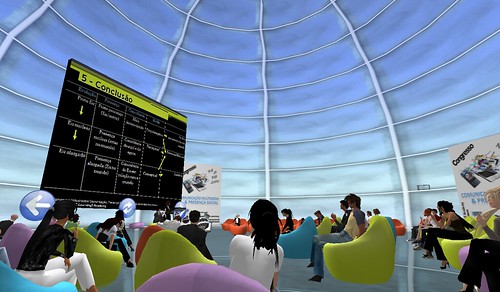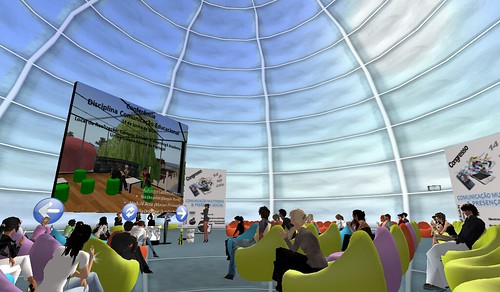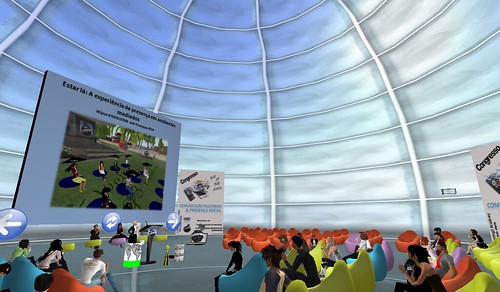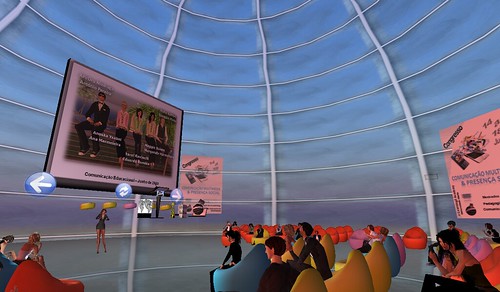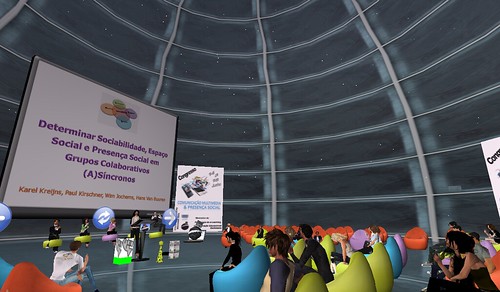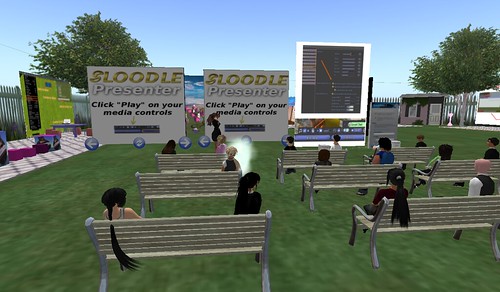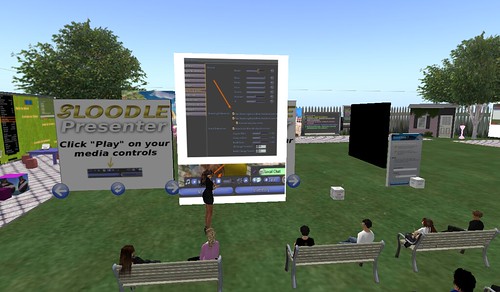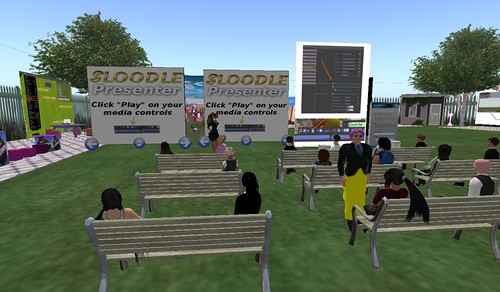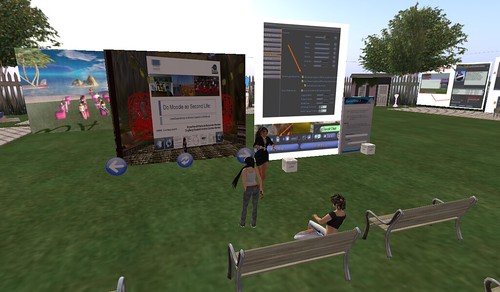
segunda-feira, 8 de outubro de 2012
segunda-feira, 12 de julho de 2010
Second Life - Passeio Informal
Olá a todos! …
…no dia 22 de Maio foi a minha estreia nos passeios informais no Second Life. E sabem que mais?! Adorei!
O destino escolhido foi o México e devo dizer-vos que achei esta escolha muito curiosa. Na vida real está quase a fazer 6 anos que visitei este país, mais propriamente a Riviera Maya, que já desde a escola básica e o estudo das primeiras civilizações me fascinava a mim e ao meu marido.
Casei em 2004 e escolhemos Riviera Maya para passar a nossa lua-de-mel. Foi uma experiência única e absolutamente espectacular. Durante a nossa estadia visitamos Cancun, uma aldeia onde vive a última tribo que nos confeccionou o almoço nesse dia e onde fizemos rapel e canoagem, e, claro, como não podia deixar de ser ChiChen Itza, a famosa cidade maya e as suas ruínas.
Chegámos a ChiChen Itza de autocarro e depois foram-nos fornecidas bicicletas com as quais, com o nosso guia turístico entramos na floresta fantástica que envolve esta cidade mítica. Foi magnífico e à medida que nos aproximávamos do centro da cidade ficávamos cada vez mais fascinados!
Aqui no Second Life, este passeio informal foi mesmo em ChiChen Itza, porém sob uma perspectiva virtual.
Assim, uma vez que já tinha visitado as ruínas de ChiChen Itza in loco, tive a oportunidade de dar o meu contributo e fui (quase) a cicerone deste passeio…se bem que, como seria de esperar, as diferenças são muitas. E, tendo em conta estas diferenças, eis algumas fotos “reais” da cidade maya mais conhecida onde em alguns casos se vêem "outros companheiros de viagem" que também se encontravam na "excursão".
Nesta foto vê-se um pouco melhor o corpo da serpente que acompanha a pirâmide no sentido descendente e que era símbolo de protecção e que também desempenhava e um papel igualmente significativo no período do "equinócio"...
A subir a escadaria interminável de "El Castilho"... por acaso não tirei nenhuma foto da vista quando cheguei ao topo, mas posso assegurar-vos que o verde não tem fim...é lindíssíma a vista!
Um trabalho extraordinário...
Passeando em plenas ruínas...
Uma foto do Cenote onde muitas jovens eram sacrificadas...a foto é bonita...mas ao vivo é de cortar a respiração... só se ouvem os pássaros e a mística que nos envolve é tremenda!
Uma foto da argola onde se encontra o campo do Jogo da Pelota. Este jogo consiste em lançar uma bola um pouco maior do que uma bola de futebol, feita em pedra, com as ancas, tendo que passar nesta argola. O chefe da equipa que ganhasse seria sacrificado aos deuses! Que prémio, hein?!
E agora seguem-se as que tirei no Second Life durante o nosso passeio, que culminou com um passeio a cavalo! Espectaculares não acham?!
Aqui estamos no interior do magnífico "El Castillo":
Um momento de pausa para decidir o que visitar a seguir...
Nas edificações que estão junto da casa do monarca...
Algures nas ruínas da vila de ChiChen Itza...
E no fim do nosso passeio...uma cavalgada!...
Antes de terminar, gostaria apenas de esclarecer o nome escolhido:
- Chi - refere-se a boca ou garganta (funda);
- Chen - indica bem, estar bem;
- Itza - nome da tribo.
Deste modo à letra ChiChen Itza possui duas interpretações, nomeadamente "o bem da boca de Itza" ou "a garganta funda e cheia de Itza" - muito curioso não acham ... pois ambas as interpretações demonstram que houve uma grande preocupação em arranjar um local onde esta tribo pudesse arranjar subsistência de modo a que os seus alicerces de existência estivesse assegurados e, foi graças a esta enorme inteligência e ao esforço colectivo que se tornou num centro de vida política, económica, religiosa e militar de grande renome, deixando um grande contributo para história mundial de todos os povos!
~~~~~~~~~~~~~@@@@@@@~~~~~~~~~~~~
Quero agradecer a todos os colegas…espero que tenham gostado da minha companhia e do meu “relato”…foi muito agradável servir de guia e foram todos um grupo de “turistas” excelente! Nota máxima!!!
Um grande obrigado mais uma vez!
quinta-feira, 24 de junho de 2010
PPEL - Unit 4: Final Report on Task 2
Review of my three LO's...
Bering in mind this task, I was asked to create a Learning Module where I would publish and present the revision's of my three LO's.
So here is my Learning Module...
For the first unit, I prepared a Learning Object in Toonlet and I published it on my blog on The Theory of Cooperative Freedom, its advantages and the most relevant characteristics. It was the first time that I worked with Toonlet and it fascinated me… for improvement, a colleague suggested putting it smaller, but due to the blog’s format it was not possible, another suggestion, this time by Professor Paulsen, was to write as shorter introduction to it at my blog which I hope to have completed successfully.
Regarding the first LO I decided to do it using Toonlet because I saw professor Paulsen’s work and I found it an interesting, appealing and – at first sight – a light and concentrated reading of the Theory Cooperative Freedom, its ideas and implications. I enjoyed working with Toonlet and I found it an excellent and challenging tool. Regarding the final work, I may say that in overall it fulfilled my expectations and I hope that in the future it may become a good resource for further students and researchers that wish to know more on the Theory of Cooperative Freedom.
For the second task of unit 2, I decided to present and LO regarding Online Teaching Techniques and Web 2.0. The original LO that I presented was elaborated using several tools, namely Powerpoint, Toonlet, Video Converter and finally Youtube to publish it.
The making of this LO was challenging and it took a lot of time to prepare it, for I had some difficulties in converting the Powerpoint presentation to video. Nevertheless, once the final product was achieved, the result did not satisfy me completely for, as Professor Paulsen well pointed out, in some situations the text was hard to read and in some cases it was hard to digest all the information, but no matter how hard I tried it was very difficult for me to improve it. So, I after the its presentation and once I got the feedback on it, I started to think on ways to improve it…I exchanged ideas with some colleagues – and I thank them for their input because it was decisive – and the final version of the LO finally arise. This last version was done using all the tool previously mentioned, but instead of the Video converter I used Windows Movie Maker, as it was well suggested by a colleague, and once the video was done I used again the Youtube to publish it.
I hope you find this version better because in fact the images are clearer, the text is easier to read and to understand and in overall it satisfies me a lot. My thanks to my colleague (!) and here is the updated version…
For the LO of the third unit, Professor Paulsen made some suggestions, namely writing the storyboard of the LO and also changing the background music for another one more calm. I found these suggestions very pertinent, because they indeed improve and contribute to the understanding of the presentation. In the end, I also did another change…I expanded the time of some slides so that the reading becomes more comprehensive and as the colleague, that reviewed it well pointed out, I also put the letters bigger. I hope you will find these changes as worthy as I did and thank you all for you feedback!
GoAnimate.com: Transparency and cooperative learning by marinampel04
Like it? Create your own at GoAnimate.com. It's free and fun!
Here is the storyboard of my LO…
This is Gerson Branco. He is a Brazilian journalist aged 32. Gerson wants to take a MA but he doesn’t know where.
It has to be a distance learning course because he is always travelling and he doesn’t have a lot of time.
This is Vera Silva. She is a Portuguese primary teacher aged 30. She met Gerson 10 years ago and they keep in touch thanks to Skype.
Vera – I’m taking an online MA at Universidade Aberta – a well known Portuguese University. It’s great! It promotes transparency and cooperative learning between students.
Gerson – Transparency? Cooperative learning? What do you mean?
Vera – Transparency means that you are able to see and follow your colleague’s work and they can also see and follow yours within a learning environment. In short, you can see others and others see you, clear?
Gerson – I understand what you mean. That’s very interesting.
Vera – Yes, it is. Transparency gives insight into each other actions and it is a unique characteristic of social networking services.
Gerson – Ok. That is also clear to me. What about cooperative learning?
Vera – Cooperative learning also takes place in networks. It encourages both individual flexibility and the affinity to a learning community.
It has an important objective within a learning community because it supports consciousness and awareness of the activities of others. It is very important to online education.
Gerson – I see what you mean. That is also very useful. But about transparency…How far does it go?!
Vera – Are you referring to the limits of transparency?!
Gerson – Of course!
Vera – Transparency must be handled carefully bearing in mind privacy issues.
Gerson – That is right! So, how far does transparency go?
Vera – You create your presentation with the necessary basic information about yourself to initiate and maintain communication online.
Gerson – What do you mean by “necessary basic information”?
Vera – Your name, a photo, e-mail address, telephone number, chatting identities, some geographical information (zip codes for example) in case of an eventual face-to-face meeting…
Gerson – Oh…ok! That’s what you mean!...
Vera – Good! Now is everything clear?
Gerson – Clear as water!!! Thank you very much Vera!!!
Vera – Glad to help you Gerson my friend and new colleague! It’s good to have you on the winning team!!! See you online!
Gerson – I will go to their homepage and get information right now! I’m so happy!!!
THE END
In conclusion...
The making of these LO’s was very significant to me, because I was able to get in touch with new realities and I enjoyed a lot in doing these activities.
At first, I may say that it was a little complicated, but as I am a persistent person, I kept trying and felt happy with the final products and their revisions.
This activity was extremely enlightening and challenging…it had an important impact in my experience as an e-learner and it helped me in systematizing the contents learnt and also in interiorizing them.
Thank you all for making it possible! @@@
PPEL - Unit 4: Final Report on Task 1
Before I start to share my final work I would like to add some comments on the method I decided to use to present it.
To begin with, , the recent changes were written with the color brown, so the difference between what is now done and what was already done is more perceptible and I also chose to use the green and italics in the transcriptions, so that they may become more noticeable… the rest of the work remains unchanged. Further, I also found pertinent to place the number of pages of each reading in the case of the Annotated Bibliographies and the date in which the documents were consulted, so that this also becomes clearer. These considerations were taken in regard when reviewing all three units and the method was also re-used in all of them.
Regarding the feedback on Unit 3…it was suggested by both Professor Paulsen and by the colleague that reviewed it… that it would be good “to write a short introduction or conclusion that brings it all together” - I decide to write a conclusion. In addition, I also decided to make some changes namely regarding the illustration…I decided to replace it with the course of a small stream to establish a comparison between transparency and the transparency of the water, the borders of the stream and the limits that each one of us has to establish regarding the level of transparency and, finally, the interaction that transparency allows in online education and course of the water, which is shown with movement and dynamism.
I hope you will find my readings as valuable and as pertinent as I did… I wish you all a safe and good reading!!!
@@@@@@@@@@
In this last unit we are asked to improve and finalize all our annotated bibliographies and learning objects. Bearing in mind this request I will now start working on unit 1 and compile it, refine it and as it was also asked to expand it.
So, bearing in mind unit 4 - Task 1 here is my final work…
~~~~~~~~~((()))~~~~~~~~~
Unit 1 – Task 1: Cooperative Freedom
Therefore, for the first task of this unit an Annotated Bibliography was prepared and presented on my blog where all the readings were shown as well as the most important aspects of them.
• Paulsen, M. F., 2008, Cooperative Online Education. Seminar.net, Vol. 4, No. 2. (20 pages)
(Research done on the 10th of March , taken from: http://seminar.net/index.php/volume-4-issue-2-2008-previousissuesmeny-124/100-cooperative-online-education )
A very “real” and up-to-date article, for it shows graphics regarding the popularity of cooperative online education among students as well as other resourceful illustrations on individual, cooperative and collaborative environments, namely regarding the question of flexibility and others. It starts by saying:
“Cooperative learning seeks to develop virtual learning environments that allow students to have optimal individual freedom within online learning communities”.
To introduce the topic it starts by doing a brief background information on cooperative online education and it refers to have been built under the scope of The Theory of Cooperative Freedom, by prof. Morten Flate Paulsen, who is also the author of the article in question. Bearing this in mind, Prof. Morten Flate Paulsen makes reference to NKI – as well as its graphics to corroborate his version -, one of his creations, that was:
and that:
“(...) it facilitates individual freedom within a learning community in which online students serve as mutual resources without being depend on each other.”
• Theory of Cooperative Freedom, MortenFP . toonlet.com (1 page)
Theory of Cooperative Freedom
by MortenFP related [www.ednews.org]
A straightforward and “amusing” way of giving highlights – sort of a BD - on online education and the Theory of Cooperative Freedom. Its author Prof. Morten Flate Paulsen presents “a concentrated recipe” about this theory in a very concise and a joyful manner by offering the reader some of the main ideas described in the thinking of Cooperative Freedom. Through the existence of individual learning, collaborative learning and cooperative learning in online environments, students, either those who search an individual way of study or a collaborative one, or a cooperative way to achieve their aims and goals within their pace, time, content, space access and medium reach their academic success.
• Paulsen, M.F. 2003, Part One: Online Education, Teaching and Learning, Cooperative Freedom: An Online Education Theory, Education Online. (12 pages)
(Research done on the 9th of March, taken from: http://www.studymentor.com/cooperative_freedom.pdf )
A very interesting, concise and challenging article that gives us insights on The Theory Cooperative Freedom, by exposing right at the top that:
“ (...) the theory of cooperative freedom argues that online education can foster both freedom for the individual and group cooperation”.
Although at first sight finding the right way to study may seem difficult to conceive and achieve for we know that while some students seek individual flexibility and freedom, others the group collaboration and social unity, this study concludes that with online education we can have the both options working side-by-side in a cooperative and flexible environment.
• Paulsen, Morten Flate et Slaatto, Torhild, 2006, NKI in Learning Partner - Opportunities for Cooperation in Distance Learning, elearningeuropa.info. (4 pages)
(Reseach done on the 10th of March, taken from http://www.elearningeuropa.info/directory/index.php?page=doc&doc_id=8294&doclng=6)
“NKI Distance Education facilitates individual freedom within a learning community in which online students serve as mutual resources without being dependent on each other."
NKI is innovative and through it individual freedom within the learning community is facilitated for with it online students voluntary may study wherever they are, they can also become mutual resources without being dependent on each other and it also offers them the possibility to start a course at any time of the year and always be able to follow their study progression.
• Millis, Barbara J.,2oo2, Enhancing Learning - and More! - Through Cooperative Learning, theideacenter.org., IDEA PAPER #38 (10 pages)
(Research done on the 10th of March, taken from http://www.theideacenter.org/sites/default/files/IDEA_Paper_38.pdf )
An overview of cooperative learning divided in subtitles. It gives brief explanations on several pertinent issues regarding cooperative learning, namely the premises underlying it, which are three; the first one deals with the respect for students:
“(...)regardless of their ethnic, intellectual, educational, or social background”
“(...) for learning, like living, is inherently social”
“ (...) learning is an active, constructive progress”.
• Tips on Cooperative Leaning
(Research done on the 10th of March, taken from http://www.youtube.com/watch?v=5LWE2HF1v1Y )
A sort of casual encounter between colleagues gives room for a talk on tips for cooperative learning for it suggests good strategies for teachers to work with students. There are several suggestions very easy to put into practise, bearing always in mind, students interest, motivation and cooperative group work input. The presentation starts from scratch, that is, it explains how to start cooperative group - pair work - and goes to bigger groups. It is a very concise way of highlighting this tipe of learning in "presential" classes.
(An updated version of the report is available in: Paulsen, M.F., Online Education and Learning Management Systems: Global E-learning in a Scandinavian Perspective [www.studymentor.com])
(Research done on the 4th of April, taken from: http://www.nettskolen.com/forskning/19/cmcped.html)
A very challenging and interesting report that puts in evidence pedagogical techniques on computer-mediated communication and it also presents an overview about them. This report, according to the author, Prof. Morten Flate Paulsen, was presented in Birmingham, England in June 26-30, 1995 at a conference conducted by the International Council for Distance Education. Bearing in mind the author’s work, the report starts by making reference to one of my favorite techniques – brainstorming. By brainstorming we understand “creation of a pool of ideas” on a specific topic and this approach helps the “class” to “break the ice” by introducing a topic which will make the group think in a creative way and expand their thoughts upon the ideas of the elements of the “class”. In this case specifically, Prof. Paulsen used this technique to lead the participants to share experiences in pedagogical techniques that have been applied in CMC.
According to Prof. Paulsen a pedagogical technique is a way of achieving teaching objectives. Throughout the report, he author also points out in a very clear and objective way that there are four pedagogical techniques: one-alone techniques, one-to-one techniques, one-to-many techniques and many-to-many techniques. Once he states them, he describes them and specifies each one bearing in mind the approaches to be used.
In this online report, Prof. Paulsen also makes reference to other books and their authors as well as their contributions for the topic in question.
To sum up, balancing to the embracement of online education by some institutions – which I am sure to increase significantly in the future - , I feel this report is very enlightening and it can also be a good resource for further researches.
Kim, Kyong-Jee and Bonk, Curtis J., 2006, The Future of Online Teaching and Learning in Higher Education: The Survey Says… - A survey substantiates some ideas about online learning and refutes others, Vol. 29, Number 4, Educause Quarterly. (16 pages)
(Research done on the 5th of April, taken from: http://www.educause.edu/EDUCAUSE+Quarterly/EDUCAUSEQuarterlyMagazineVolum/TheFutureofOnlineTeachingandLe/157426)
An interesting and well illustrated survey based on a study conducted by a group of individuals that believed to have relevant experience and insights regarding the present and future conditions of online education. This survey was also built as a way to understand and to bring insights to the use of technology in teaching, within both higher education and corporate training settings. This survey takes place from late November 2003 to early January 2004 and it shows several demographics of online instructors to portray a significant perspective of online teaching, its growth, its expected quality, its pedagogical techniques and it also presents predictions on to measure the quality of online teaching in the future. A good overview of the future of teaching in online environments.
Salter, G. and Hansen, S., Modelling New Skills For Online Teaching, Department of Computing and Information Systems, University of Western Sydney. (16 Pages)
(Reseach done on the 5th of April, taken from: http://www.ascilite.org.au/conferences/brisbane99/papers/salterhansen.pdf )
The content of this article is easy to grasp and it draws our attention to the need and (continuous) search for modeling new skills for online teaching. The authors make reference to the advantages of online material and describe the included methods for teaching online: asynchronous computer mediated communication, synchronous computer mediated communication, online assessment, learning resources, documents, multimedia, links to external resources and student prepared material.
The article also puts into evidence the new role of the teacher, which is now a facilitator instead of an expert authority (old perspective).
Another aspect that is also highlighted is the importance of the real and constant need to evolve because “as technology is evolving so rapidly (…) new teaching possibilities arise regularly” and we must be prepared for that.
I found this article very lighthearted and interesting for it deals with the urgency to monitor and update teaching strategies in order to teach successfully in an online environment.
Bawden, David. Robynson, Lyn et al., 2007, Curriculum 2.0? Changes In Information Science Education for a Web 2.0 World in Digital Information and Heritage, INFuture 2007. (13 Pages)
(Research done on the 6th of April, taken from: http://infoz.ffzg.hr/INFuture/2007/pdf/1-03%20Bawden%20et%20al,%20Curriculum%202.0.pdf)
Web 2.0 is depicted as an essential facilitator of online teaching for it:
“provides both the content of learning, and the tools to promote learning itself.” (p. 39)
“…the use of Web 2.0 facilities by academic staff themselves, for their own purposes, will enhance their understanding, and hence promote more credible teaching.” (p.40)
(Research done on the 5th April, taken from: http://staging.iste.org/Content/NavigationMenu/Research/NECC_Research_Paper_Archives/NECC2008/Shihab.pdf)
A very challenging and stick to the point approach on Web 2.0 taking into account its huge role in online teaching and more precisely in English Language Classes.
“Web 2.0 tools, namely blogs, wikis, podcasts, and RSS were introduced to change teaching practices of in-service high school teachers to improve the collaboration of today’s students in the English language classroom.” (p.1)
Unit 3 - Task 1: Transparency in Online Education

“What we REALLY need is the pertinent information to the situation AND to get to know each other."
in Missing the Point: Transparency without Authenticity. (http://allenjfuller.com/2010/02/missing-the-point-transparency-without-authenticity/
• Paulsen, Morten Flate et Dalsgaard, Christian. Transparency in Cooperative Online Education. June 2009. (12 Pages)
(Research done on the 3rd of May, taken from: http://www.irrodl.org/index.php/irrodl/rt/printerFriendly/671/1267)
This is a very interesting and pertinent article when dealing with transparency in online teaching education for it is about the impact and the pedagogical potential that social networking has as a facilitator of transparency and awareness among students. Bearing in mind that the aim of transparency is:
- Individual learning, which as the name indicates is conducted alone with no interaction of a learning community;
- Collaborative learning, which happens in face-to-face meetings and online education and that requires the input of a group and consequently limits the individual;
- Cooperative learning, which seeks to foster some of the benefits of individual freedom and the benefits of cooperation in online learning communities and that takes place in networks.
Nevertheless being as authentic as possible also raises other controversial questions which are also dealt the level of authenticity and of privacy. Regarding these two questions the authors create a “Transparency Barometer” to analyze them and later in the part dedicated to Cooperative Student Catalogues they point out what they consider essential to be authentic in order to facilitate cooperation:
In my opinion, the choice of this article is very important for it cleared my mind regarding transparency in online teaching education. I found it also enriching to see how the two authors dealt with the question of authenticity, its impact in the course’s development and in teachers and students’ interactions during the studies.
• Bowles, Michelle. 5 Twitter Tips for Staying Authentic and Transparent. 2009 (28th September) (7 Pages)
(Research done on the 3rd of May, taken from: http://www.toprankblog.com/2009/09/twitter-tips-authentic-transparent/)
In 5 Twitter Tips for Staying Authentic and Transparent, Michelle Bowles presents in a very straightforward way five tips on how to be authentic and transparent, which I will start to explain:
1. The first one deals with the placing of a photo and a name for this helps to establish connections with the ones that look at our work or that wish to interact with us, for in fact:
2. The second one is regarding personality and it is in favor of showing that in fact we are “real individuals” with feelings and humor for:
3. Regarding the third one it is important that you admit when you are wrong, not only because with mistakes we learn, but also because it is part of our nature and people make mistakes and they must also know how to cope with them.
4. On the fourth one, it deals with “Get to know your followers” it is important to be known but it is also important to know who you are dealing with, so this fourth tip is about asking questions simple questions about themselves, such as name, age, interests (nothing too personal).
5. The last one is “Don’t get carried away by your accomplishments” and the tip is that you should not let your success get to your head for it were your followers that gave it to you and that have largely contributed for it. So remember…be modest!
I found this text interesting, easy to read and with good tips regarding our present in Online Teaching Education and one of the sentences that exemplifies what is presented is “Be authentic and transparent in all you do.”
• Hill, Christopher. Principles for improving Online Transparency. 2008 (1st April). (4 Pages)
(Research done on the 4th of May , taken from: http://www.facultyfocus.com/articles/distance-learning/principles-for-improving-online-transparency-quality/)
The reading of this article gives emphasis to the idea that a “well-informed student or prospective student – benefits everyone.” In addition, this article depicts the theory that everybody, universities and colleagues only have to gain with transparency and to defend this thought three principles are mentioned and explained for the institutions that seek and want transparency.
1. Make distance education a central element of your mission – if you are dealing in fact with distance learning make sure that you are ready for it and be prepared, so that your students may have access to all resources online in order to carry out a good quality program;
3. Responsiveness – means that an educational institution must be prepared to respond quickly to an online-student so that he may have feedback as soon as possible within 24 to 48 hours;
• Dalsgaard, Christian. Social Networking Sites: Transparency in Online Education. (11 pages)
(Research done on the 3rd of May, taken from: http://content.yutu.com/Library/A1mvrs/TransparencyinOnline/resources/32.htm)
An excellent approach on the pedagogical potentials of networking sites bearing in mind the fact that these sites are a combination of personalization and socialization regarding those that in a transparent way truly take part in them. According to this study when students take part in these networking sites and publish their thinking, aims, works and share it with others they are being transparent, that is they:
This challenging and amazing reading delves into the impact of social networking sites and the transparency that they involve when dealing with online teaching.
• Paulsen, Morten Flate. Profiling Online Students. (2 Pages)
(Research done on the 4th of May, taken from: http://content.yutu.com/Library/A1mvrs/TransparencyinOnline/resources/43.htm)
This interesting article aims to the use of transparency in Online Teaching and describes one of the strategies used to develop this idea of transparency at NKI Distance Education and the impact they had in it.
In order to develop, promote transparency and future situations with it, a profile was created where students are given the choice to do their presentations and t publish them in an “open catalogue”, by clicking the “global visibility checkbox” in their profile. Later, when analyzed the impact of this measure, the following conclusions were achieved:
2. “The users are excellent ambassadors for NKI when they share their presentation with others. They provide a lot of relevant information for prospective students and key words for the search engines.”
3. “…the fact that so many serious, hard-working and successful students are willing to share achievements and experiences in an open, online catalogue is valuable for the field of online education.”
In my opinion this was truly an amazing finding to promote transparency among online teaching.
• Siemens, George. Teaching as Transparent Learning. (4 Pages)
(Research done on the 3rd of May, taken from: http://content.yutu.com/Library/A1mvrs/TransparencyinOnline/resources/55.htm)
“I’ve gained much from being a transparent learner.”
George Siemens, the author, describes his path, experiences and progress as a transparent learner. According to him transparency is an important and significant requisite in online teaching for “when we make our learning transparent, we become teachers” and “watching others learn is an act of learning” for as he clearly point out:
“When someone decides to share their thoughts and ideas in a transparent manner, they become a teacher to those who are observing. Social technology - such as Twitter, blogs, Facebook – opens the door to sharing the process of learning, not only the final product.”
I found this reading encouraging and appealing for it deals with the experience of a “transparent learner” and his personal sharing of it.
• Paulsen, Morten Flate. Transparency for Quality. Toonlet.
Transparency for Quality
by MortenFP related [www.seminar.net]
(Research done on the 4th of May, taken from: http://toonlet.com/creator/MortenFP)
• Paulsen, Morten Flate. Transparency for Cooperation. Toonlet.
Transparency for Cooperation
by MortenFP related [www.seminar.net]
(Research done on the 4th of May, taken from: http://toonlet.com/archive?i=11245)
This comic strip deals with matters related to the cooperation that the use of transparency promotes in online teaching. When students give personal and transparent information about themselves other students interact more and a sense of cooperation is established between them. Nevertheless, an essential point is also presented - students’ transparency is to be handled carefully regarding their privacy and in this way students themselves should be the ones to choose the level of transparency to be allowed.
• Welcome to my PLE! - A Personal Tour by a 7th Grade Science Student.
(Youtube Presentation)
(Research done on the 4th of May, taken from: http://www.youtube.com/watch?v=YEls3tq5wIY)
I choose this Youtube Presentation because I found it a good example of transparency. Although it was created by a young student, matters such as organization and transparency are very clear and were carefully dealt and are now presented in a very objective way. This “PLE” – Personal Learning Environment - is the culminate of a research and intense work on networking sites, for as the student clearly points out he “spent some time since the beginning of the school year learning how to find information online and how to pull it out together on a personal page”, which we can observe thanks to its publication.
• Final considerations...
Bearing in mind my readings, I conclude that in attended classes cooperative learning provides for students’ interaction in heterogeneous groups for it is built with the purpose of offering a leaning support for the elements of the group. In online education, cooperative learning provides the encouragement of individual flexibility and the affinity of learning within an educational community (Prof. Morten Flate Paulsen, 2003).
Although these two perspectives may seem difficult to combine, for they lead us to a controversy, the truth is that cooperative learning in online learning environments emerges as the solution for it emphasizes the co-existence of students that enjoy individual work and its benefits and outcomes, and the others that prefer the benefits of collaborative learning, or a so called, a learning community.
“Future adult students will seek individual flexibility and freedom. At the same time, many need or prefer group collaboration and social unity. These aims are difficult to combine, but online education, when integrated with other media, can be the means of joining individual freedom and collective unity into a truly flexible, cooperative distance educational programs.”
(Prof. Morten Flate Paulsen, in Cooperative Freedom: an Online Theory Education, 2003)
Therefore, now that my opinion is truly formed, I am happy and proudly I say:
I have gained, I am gaining and I hope to continue to gain much from being a transparent learner!*
(*This last sentence was readapted from “I’ve gained much from being a transparent learner.” by George Siemens in Teaching as Transparent Learning.)
quarta-feira, 16 de junho de 2010
Comunicação Educacional - Aulas no Second Life
Olá, hoje é a nossa apresentação…seremos o último grupo…torço para que corra tudo bem tanto a nós como ao 4º grupo!!! Coragem…está quase na recta final…
4º Grupo – Grupo GARRISON
O texto que este grupo trabalhou abordava pesquisas recentes sobre o modelo COI, em especial tendo em mente a “Presença Social”, Cognitiva e, como não podia deixar de ser, a questão do ensino.
Devo dizer que este grupo defendeu o seu trabalho de modo excelente e a sua apresentação foi também muito boa – portanto, meus caros, tarefa superada!!!
Seguiram-se os habituais comentários positivos, aplausos, a opinião e a já tradicional questão do professor.
E eis que agora somos nós…
5º Grupo – Grupo KEHRWALD
Tema: “Comprendendo a Presença Social em Ambientes Virtuais de Aprendizagem Baseados em Texto.”
O nosso trabalho analisou as questões em torno da noção de “Presença Social”, nomeadamente a sua definição, a sua natureza, papel e função, sem esquecer o modo com esta é sustentada e estabelecida em ambientes de aprendizagem online. Igualmente pertinente e objecto de estudo foi uma perspectiva de “presença social” ilustrada na acção humana em contextos online.
Acho que apresentamos bem o nosso trabalho e que o autor do nosso texto teria orgulho em nós! (Pelo menos é o que espero!) Apesar das dificuldades técnicas que nós surgiram nesta etapa…penso estarmos todos de parabéns!!!
Também connosco se seguiram os comentários positivos, os aplausos e como não podia deixar de ser a questão do professor.
~~~~~~~~~~~~~~~{{{{}}}}~~~~~~~~~~~~~~~
Adorei a participação neste congresso e devo dizer que me senti tão nervosa com se fosse uma apresentação presencial e preparei-me do mesmo modo também! Sinto que todos nós ao trabalharmos os nossos textos respectivamente "demos" um pouco de nós e esse complemento enriqueceu-nos e amadureceu-nos, na medida em que eles, se é que o posso dizer, se tornaram um pouco "nossos"!
Foi um momento vivido com nervos e com uma intensidade muito grande…desde já os meus agradecimentos à Mysa, ao professor e a todos os colegas por serem uma parte integrante desta experiência fantástica e alucinante!!!
Muito obrigada… ;-)
Comunicação Educacional - Aulas no Second Life
Nesta primeira parte do congresso três equipas fizeram as suas apresentações, que passo a descrever muito resumidamente e a ilustrar com as fotos que tirei dos momentos mais significativos…
1º Grupo – Grupo RIVA
Tema: “Comunicação Multimédia e Presença Social. As Camadas de Presença: Uma Abordagem Bio-Cultural para Compreender a Presença em Ambientes Naturais Mediatizados.”
O tema trabalhado por este grupo era relativo às dimensões de “Presença Social” mas tendo em conta uma noção de presença tendo em conta uma perspectiva externa e enquadrando-a numa vertente essencialmente psicológica, e consequentemente filosófica.
Após a apresentação seguiram-se muitos aplausos, palavras de apreciação muito positiva e o nosso professor Ongberg Bluebird teceu os seus comentários e colocou uma questão.
Muito bem Grupo RIVA – tarefa superada!
2º Grupo – Grupo IJSSEL
Também a este grupo se seguiram comentários, muitos aplausos e considerações por parte do nosso professor e houve igualmente espaço para uma questão.
Os meus sinceros parabéns pelo trabalho desenvolvido e apresentado!!!
3º Grupo – Grupo KREJINS
Tema: “Determinar Sociabilidade, Espaço Social e presença Social em Grupos Colaborativos (A)Síncronos.”
A temática abordada por este grupo centra-se na importância das interacções sociais tendo em vista a aprendizagem em contextos e ambientes CSCL.
Esta foi a última apresentação da noite e podemos dizer que terminou com chave de ouro pois os colegas saíram-se muito bem! Houve comentários positivos e aplausos…
O nosso professor teceu algumas considerações e colocou a já esperada questão.
~~~~~~~~~~~~{{{}}}}~~~~~~~~~~~
Relativamente a esta primeira fase do congresso devo dizer que está a ser uma experiência fantástica e única. Sinto que me tenho vindo a preparar diariamente para um momento singular e que é já amanhã pois somos o 5º Grupo… só espero estar à altura deste e que corra tudo bem para todos nós. Acredito que temos vindo a desenvolver laços uns com os outros de certo modo mais puros do que se estivéssemos em aulas presenciais. A cada dia que passa sinto-me mais rica com esta experiência…adoro cada momento! Obrigada por tudo…
Comunicação Educacional - Aulas no Second Life
Olá a todos,
Esta última aula foi particularmente difícil para mim…pelo que passo a descrevê-la…
Hoje andámos às voltas com o SLOODLE presenter e a sua utilização.
O SLOODLE presenter é uma peça fundamental para as nossas apresentações pois é nele que o nosso trabalho vai ser projectado, além de permitir também visualizar apresentações e páginas de internet.
Uma vez tido o primeiro contacto teórico, foram-nos dadas indicações para experimentar esta ferramenta única do SL, alertando-nos no inicio da necessidade de configurar este equipamento a fim de o preparar para o propósito que pretendemos. E, face a esta questão, e para a exemplificar, a Mysa criou diapositivos - que desde já quero dizer que estavam absolutamente espectaculares – relativos ao nosso percurso como estudantes no SL que foram depois projectados neste ecrãn.
E, perante está vitória muito desejada quero novamente agradecer à Mysa…
Muito obrigada Mysa por todas as experiências e momentos únicos aqui vividos!
A passos largos chegam as datas do congresso que começa no dia 14 de Junho e é aqui nesta árdua tarefa que os nossos esforços se concentram! Boa sorte a todos!!!





